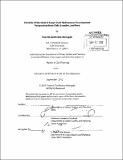| dc.contributor.advisor | Lawrence Susskind. | en_US |
| dc.contributor.author | Zambrano-Barragán, Patricio Xavier | en_US |
| dc.contributor.other | Massachusetts Institute of Technology. Dept. of Urban Studies and Planning. | en_US |
| dc.coverage.spatial | s-cl--- s-ec--- s-pe--- | en_US |
| dc.date.accessioned | 2013-03-13T15:53:31Z | |
| dc.date.available | 2013-03-13T15:53:31Z | |
| dc.date.copyright | 2012 | en_US |
| dc.date.issued | 2012 | en_US |
| dc.identifier.uri | http://hdl.handle.net/1721.1/77838 | |
| dc.description | Thesis (M.C.P.)--Massachusetts Institute of Technology, Dept. of Urban Studies and Planning, 2012. | en_US |
| dc.description | Cataloged from PDF version of thesis. | en_US |
| dc.description | Includes bibliographical references (p. 142-149). | en_US |
| dc.description.abstract | In recent years, governments in South America have turned to large-scale hydropower as a cost-effective way to improve livelihoods while addressing the energy 'trilemma': ensuring that future energy technologies provide effective solutions to climate change, environmental degradation, and security of supply. This work explores the rapidly-changing context for hydropower in South America by looking at three flagship projects: Ecuador's Coca-Codo-Sinclair (1,500MW), Chile's HidroAysen (2,750MW), and Perú's Inambari (2,000MW). Based on three months of fieldwork interviewing key actors in these countries, this thesis makes three primary claims. First, large-scale hydropower projects are evaluated against a small universe of alternatives. These three sample projects are considered not as the best option among a set of potential plants, but rather with respect to its possible iterations vis-à-vis a specific political goal, such as security and sovereignty, fast GDP growth, or regional integration. This approach has resulted in considerable social and environmental conflict. Second, state mediation of conflict has been further complicated by the presence of new sources of financing for large infrastructure development-what the thesis refers to as "south-south development ventures," through which national governments spearhead domestic infrastructure development that does not rely on 'traditional' financing sources from multilateral organizations. The prominence of these money sources denotes a clear historical departure away from universal standards and toward bilateral management of decisionmaking processes. Third, Ecuador, Chile, and Perú illustrate the overlap of diverse ecosystems and settlements on and around hydropower sites. Regardless of the regulatory framework governing energy planning in the case countries-it ranges from highly centralized in Ecuador to completely liberalized and market-based in Chile-the state has found makeshift regulatory or judicial solutions for this overlap. Large emblematic projects such as Coca-Codo-Sinclair and HidroAysen have the potential to turn these state responses into landmark decisions about future projects and the territories around them. Public opposition resulting from this overlap reveals clear inadequacies in the way these countries plan and develop high-interest infrastructure projects. The implication is that opportunities exist to make hydropower a credible option to meet the energy trilemma if state actors are willing to think beyond the "decide-announce-defend" model of decision-making and if South American countries can set up a regional, independent, third-party oversight body to mediate between the state, project sponsors, and civil society actors. | en_US |
| dc.description.statementofresponsibility | by Patricio Zambrano-Barragán. | en_US |
| dc.format.extent | 149 p. | en_US |
| dc.language.iso | eng | en_US |
| dc.publisher | Massachusetts Institute of Technology | en_US |
| dc.rights | M.I.T. theses are protected by
copyright. They may be viewed from this source for any purpose, but
reproduction or distribution in any format is prohibited without written
permission. See provided URL for inquiries about permission. | en_US |
| dc.rights.uri | http://dspace.mit.edu/handle/1721.1/7582 | en_US |
| dc.subject | Urban Studies and Planning. | en_US |
| dc.title | The Role of the state in large-scale hydropower development perspectives from Chile, Ecuador, and Perú | en_US |
| dc.type | Thesis | en_US |
| dc.description.degree | M.C.P. | en_US |
| dc.contributor.department | Massachusetts Institute of Technology. Department of Urban Studies and Planning | |
| dc.identifier.oclc | 828677819 | en_US |

